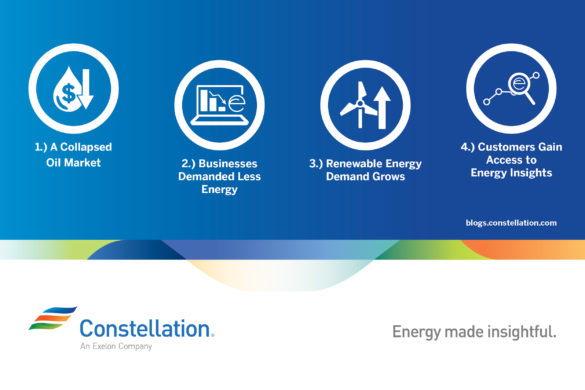A Look Back: 2020 Trends in Energy Recap
3 min readIn less than a year, the COVID-19 pandemic has affected companies in all industries and regions. To respond to these effects, new trends and technologies in energy have emerged. Constellation regularly monitors these trends to provide customers with intel to help them optimize their energy purchasing strategy.
Here we highlight four events and trends that impacted the energy landscape, from pricing dynamics to emerging technology, over the last year.
1. A collapsed oil market created a surplus and crashed prices.
One of the most notable events in 2020 was the collapse of the oil market in April. The shock value associated with the market plummeting to a negative number on the stock exchange for the first time in history was met with immediate and lasting implications. What led to the collapse?
At the height of stay-at-home orders due to COVID-19, U.S. energy consumption fell to its lowest level in more than 30 years, according to the Energy Information Administration. In addition, the United States is the largest producer of crude oil in the world, but as consumers dramatically decreased their use of fuel for cars, boats, planes and other means of transportation, oil was suddenly in surplus and the price nosedived.
To adjust to the situation, operators shut down oil wells to limit output in major regions. The stoppage in production saw the subsequent collapse of price in commodities like natural gas and exports. Thereafter, many oil and shale producers were forced to restructure to create an environment where they could be financially prudent.
2. Retail energy providers carried more risk as commercial businesses demanded less energy.
Beginning as a COVID-19 mitigation effort, more and more commercial businesses and corporate offices turned work from home orders into long-term operating models. The cost savings associated with this work environment are too attractive to pass up for many businesses.
Even as some restrictions have lifted, there are still unknowns around customer energy usage; this uncertainty and how it impacts revenue are challenges that energy providers continue to navigate. Suppliers have had to continuously monitor customer usage trends in order to forecast pricing, as well as experiment with new products and cost mechanisms to manage risk in their commercial contracts.
However, the forced acceleration of technology as a result of COVID-19 mitigation efforts has also proven useful to energy providers and other retailers. The uptick in video platforms and e-commerce technology affords energy providers a more robust digital highway to reach customers in all places, which just like other commercial business operating models, is expected to continue for years to come.

3. Bullishness in renewable energy and related technologies.
Even before COVID-19, sustainability had been a recurring theme in the energy industry. In an era of relative uncertainty, we have seen continued momentum around technologies like solar and battery storage. The demand for renewable products continued to grow from self-imposed sustainability goals in the private sector to state-level renewable mandates. For example, in 2020, many states established carbon-free goals by target dates, and corporations began entering 10- to 15-year renewable project contracts. These activities indicate a perpetual focus on environment, social and corporate governance, and the role that renewable technology will play in helping both the public and private sector customers reach their goals.
4. Continued analytics activity to democratize energy usage information and deliver solutions.
During the dynamic year of 2020, energy providers have remained flexible thanks to analytics and data platforms used to monitor customer usage, forecast pricing and inform potential recovery patterns. While in the early stages of innovation, analytics platforms have also continued to gain prominence and become more accessible in the energy and electricity sector. Analytics provide valuable insights for customers to better understand their energy usage and implement solutions to meet sustainability requirements and efficiency goals.
At the end of 2020, forecasts for the gross domestic product (GDP) were close to zero, according to Exelon Chief Economist Ed Fortunato. However, the remarkable rebound speaks to the resourcefulness of American companies in all industries, including energy, in navigating and responding to this new environment.
To stay apprised of trends and market intel, subscribe to our email communications, such as weekly storage updates and invitations to our monthly Energy Market Intel Webinar.

